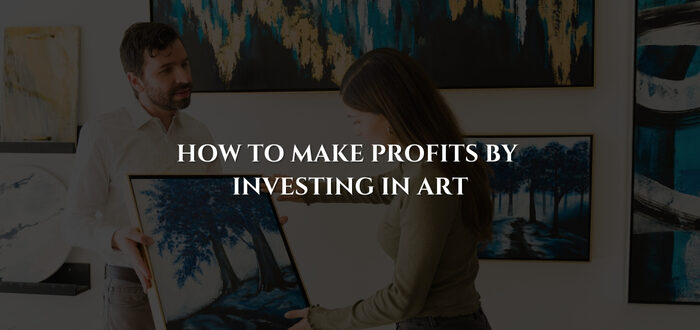A Beginner’s Guide: How To Make Profits Through Art Investments
The fine art market is thriving, with new auction records seemingly set daily for the “highest price ever paid.” But what does that mean for the painting you purchased a few years ago simply because it matched your sofa? It could appreciate in value—or it might end up being about as marketable as an art project from your child.
So how do you figure it out? Like any investment, you need to dig into the details. The art world is unpredictable, and profits are never guaranteed, but with some research and planning, you can adorn your home with pieces that could become valuable assets over time.
In this article, we will discuss why you can invest in paintings and provide some key advice for investing in art for beginners
Before making a decision for purchasing art for investment purposes, one must keep in mind what determines its value.
Factors that determine the value of art:
Artist’s Reputation and Recognition
Established vs. Emerging Artists: Works by well-established artists with a strong reputation, like MF Husain or Pablo Picasso, often command higher prices. Emerging artists, though riskier, can offer significant potential for appreciation if they gain recognition.
Provenance and Authenticity
Provenance: The history of ownership, or provenance, plays a key role. Art with documented, prestigious ownership or connection to notable collectors, museums, or exhibitions can fetch higher prices.
Authenticity: Verified authenticity through certificates or expert evaluations adds to the artwork’s value. Forgeries or unverified pieces lose credibility and market value.
Rarity and Supply
The scarcity of an artist’s work, especially when the artist is no longer creating, can drive up prices. Limited editions or unique pieces, as opposed to mass-produced works, tend to hold more value.
Cultural Impact
Art that represents a significant moment in history, or a cultural movement tends to increase in value over time. Pieces tied to iconic movements like modernism, surrealism often attract high interest.
Market Conditions and Economic Climate
Art Market Trends: Fluctuations in the global art market, fuelled by auction records, celebrity endorsement, can affect an artwork’s value.
Economic Factors: Global financial conditions, inflation, and interest rates influence the discretionary income available for luxury goods like art, which can impact investment values.
Building an Art Collection
The Indian art market is one of many that has generated excitement among prospective collectors interested in investing in art.
Key Factors to Consider Before Making Purchases
Develop Your Taste: While art investment can be appealing, it should not be the primary focus; it’s essential to choose pieces that you will enjoy living with.
Do Your Research: “Start by browsing auction catalogues,” experts suggest, “as these works are typically researched, vetted, and priced according to the current market.” Once you’ve identified a potential piece, it’s important to dig deeper into the artist’s background.
Artistic Medium and Materials: The medium and materials used in an artist’s work are also significant considerations. An artist may be well-known, but only certain styles or periods of their work might be in demand. This is where collectors can sometimes go wrong, ending up with pieces that may not hold much monetary value in the future.
Diversify your Collection: A well-rounded art collection should be diverse. Experts recommend that “50 to 60 percent of the collection should feature modernist works, with around 15 to 20 percent devoted to pre-modernist artists who have already established their reputations.”
Works by Indian modernists such as MF Husain, SH Raza, FN Souza, Manu Parekh, as well as pre-modernists like Raja Ravi Varma, and Jamini Roy, continue to be highly sought after, with limited availability driving demand.
Risks In Art Investment
Investing in art can offer significant benefits, such as portfolio diversification, aesthetic enjoyment, and potential financial returns.
However, like any investment, it comes with its own set of risks. Being aware of these risks allows investors to make more informed decisions and take steps to mitigate them.
Here are some key risks involved in art investment:
Forgeries and Authenticity Issue
One of the biggest risks in art investment is buying a forgery or counterfeit. Unscrupulous sellers may offer fake pieces, especially when dealing with high-demand or rare works.
High Transaction Costs
Buying and Selling Fees: Auction houses, galleries, and dealers often charge high commissions on sales, which can reduce the net profits from art investments.
Storage and Insurance: High-value art pieces require specialized storage conditions and insurance. Maintaining the right climate, security, and insurance policies can add ongoing costs to art ownership, affecting overall returns.
Tax Obligations
When investing in art, it’s important to be aware of the tax implications, as these can impact your overall returns.
Capital Gains Tax: When you sell a piece of art for a profit, you may be required to pay capital gains tax on the earnings. Be aware of the current tax rate and consult an expert in case of doubts.
When purchasing art, you may also need to consider sales tax, which varies by location.
Emotional Bias
Emotional attachment to a particular artwork can lead to overpaying, especially if the purchase is driven more by personal taste than investment value.
By evaluating these rewards and risk factors, potential collectors and investors can make more informed decisions when purchasing art with the expectation of future appreciation.
Conclusion
Investing in art can be a rewarding experience both financially and emotionally. By taking the time to understand the market, develop your taste, and work with experts, you can make informed decisions that increase your chances of success. Art is a long-term investment that requires patience, research, and a passion for the pieces you choose. With these strategies, beginners can confidently begin their journey into the world of art investment.
Discover the Masters of Modern & Contemporary Art
Giftex, one of the most popular auction houses is proud to announce its Modern and Contemporary Art Auction on the 14th and 15th of October 2024.
Step into the world of extraordinary art at the Giftex Upcoming Modern & Contemporary Art Auction, where iconic masterpieces and fresh talent come together under one roof!
This is your chance to own a piece of art history!






